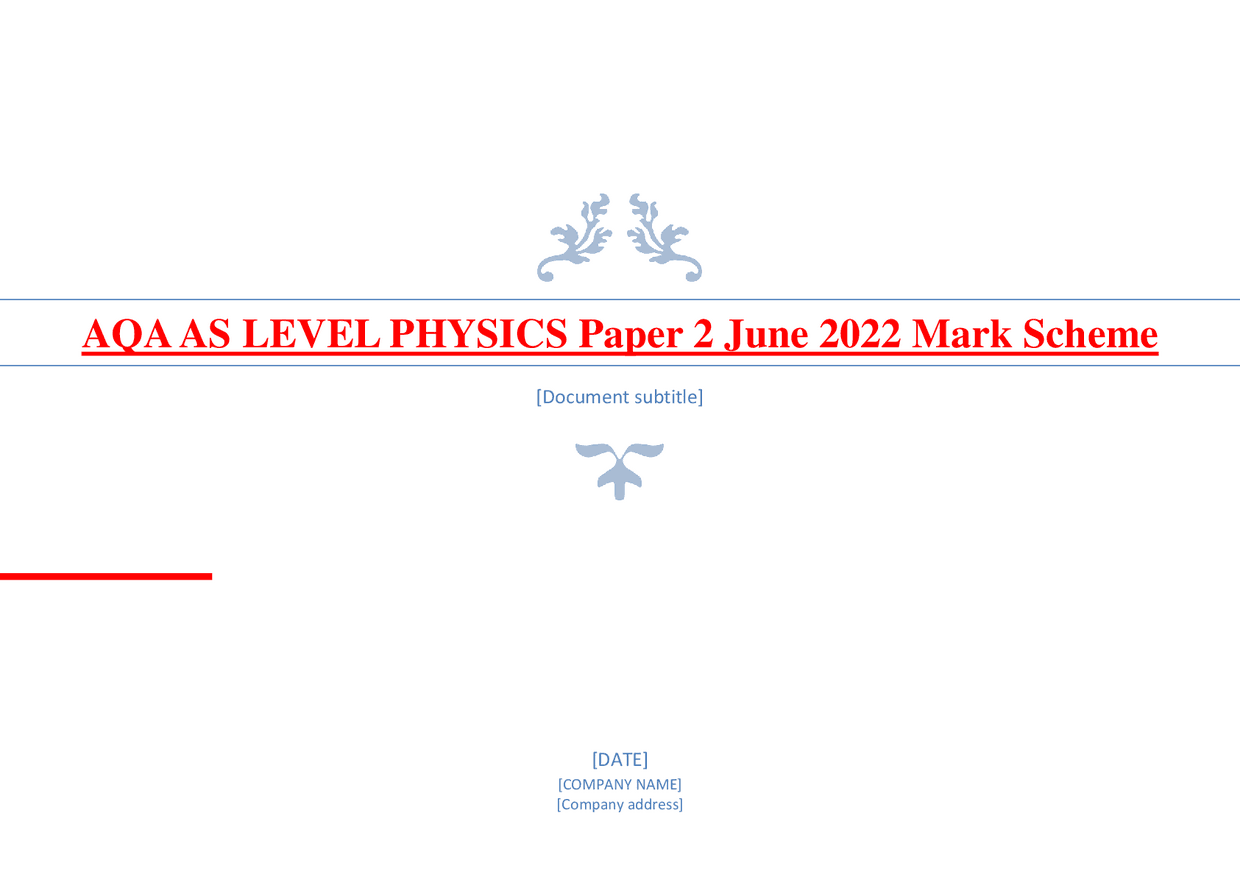

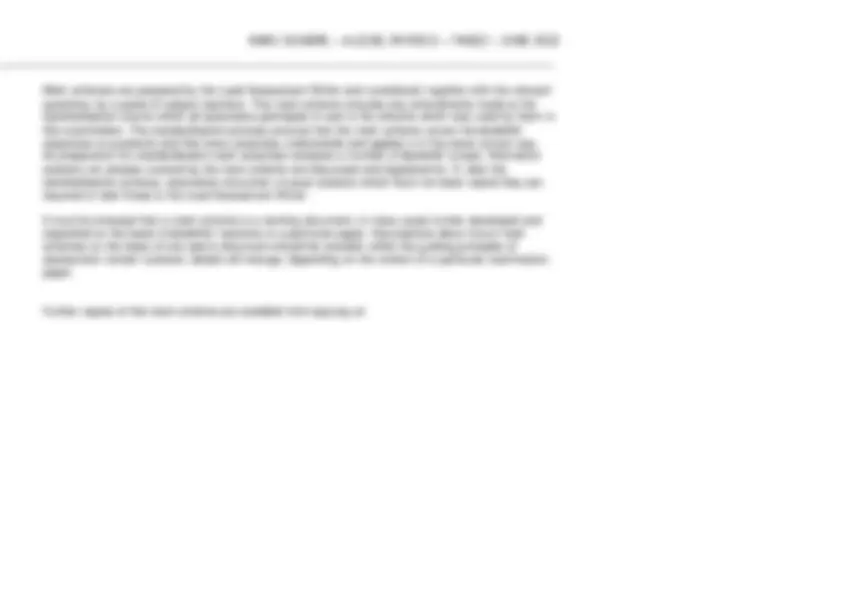
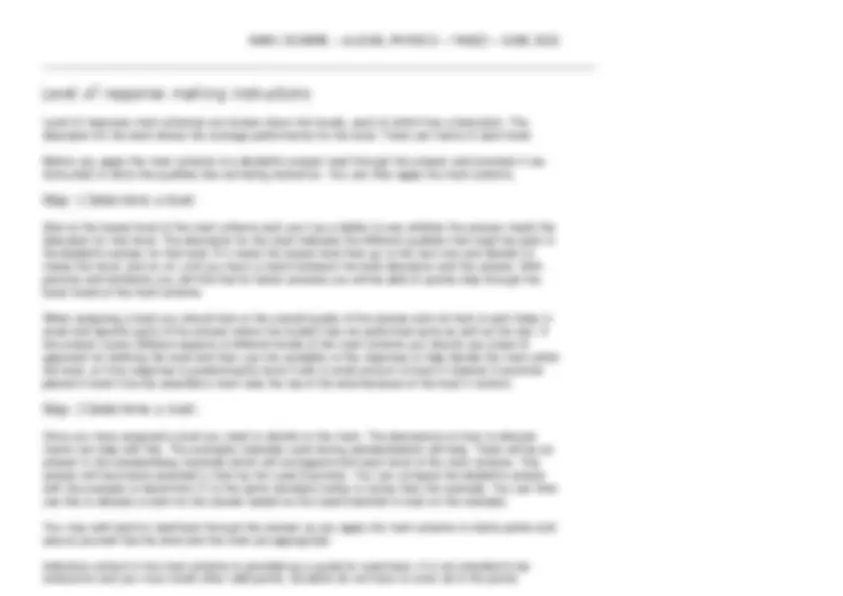
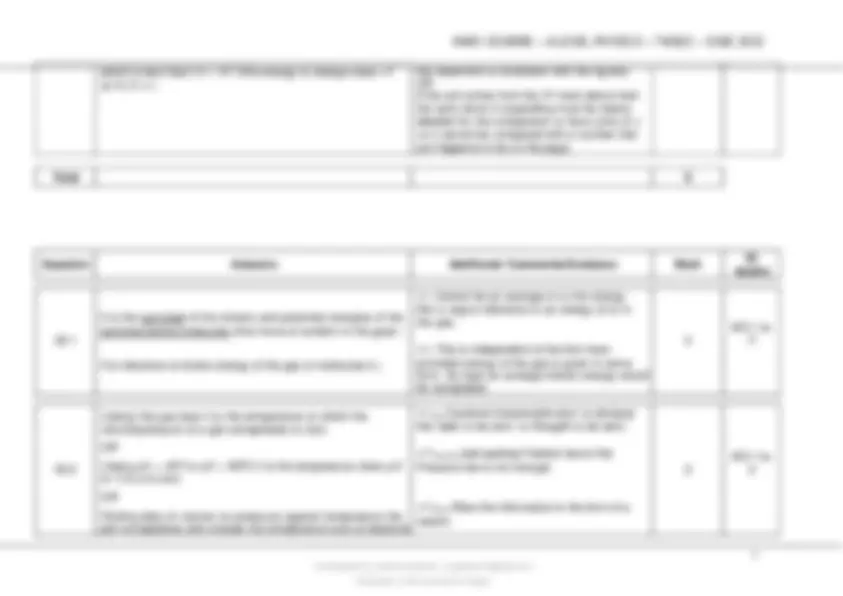
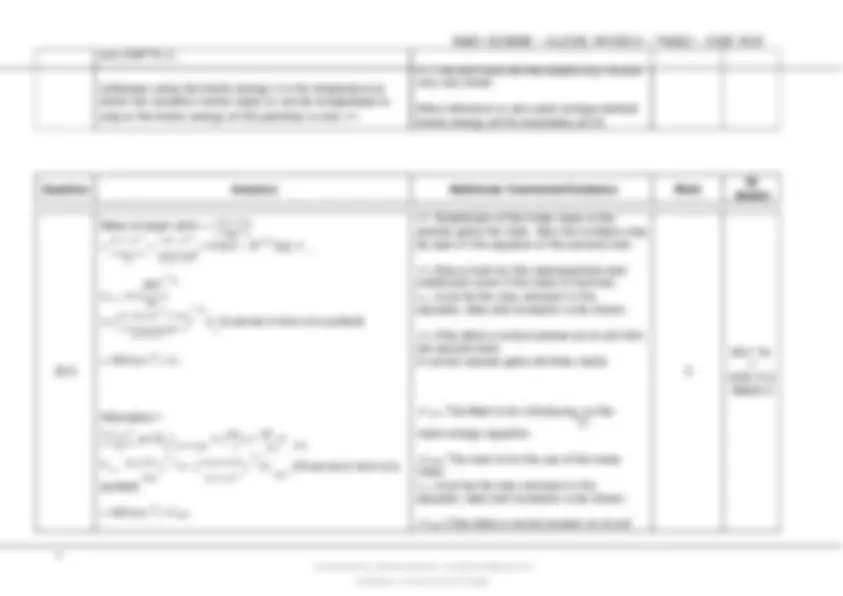
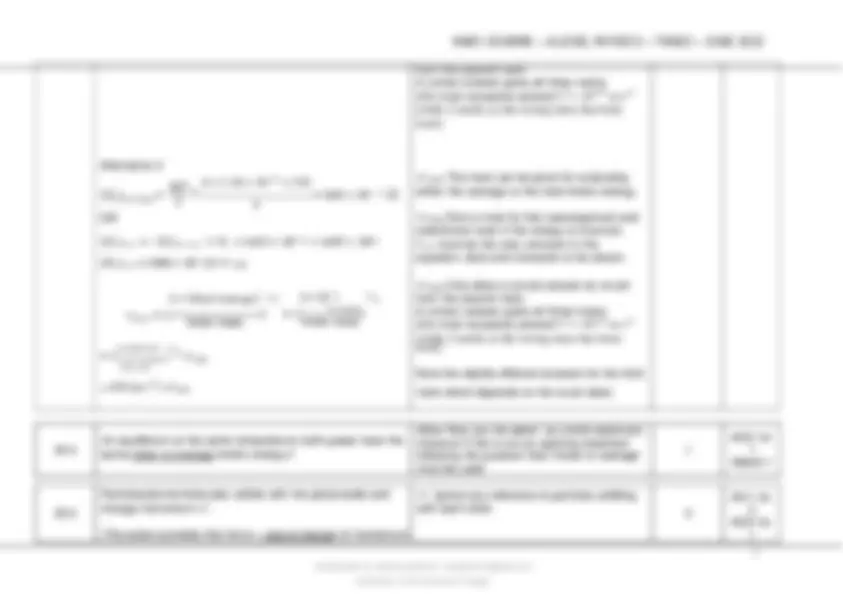
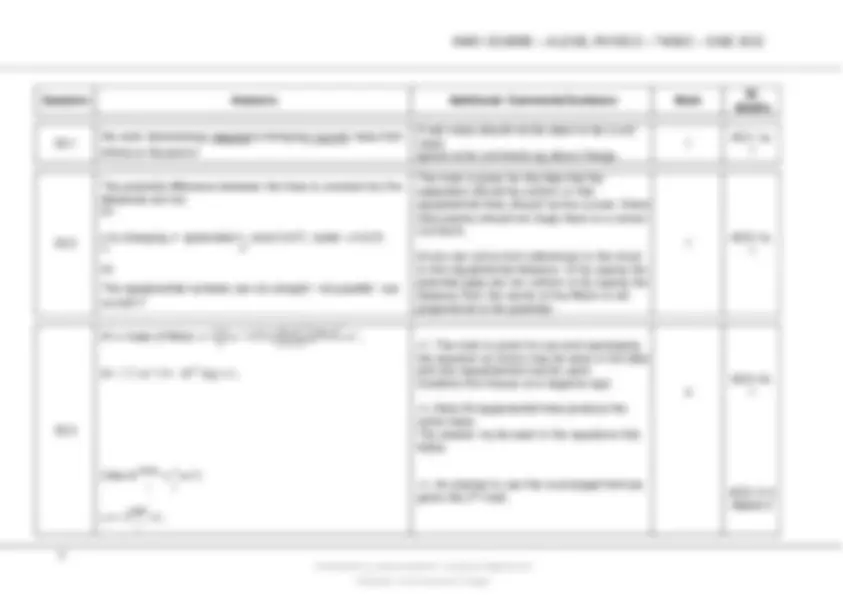
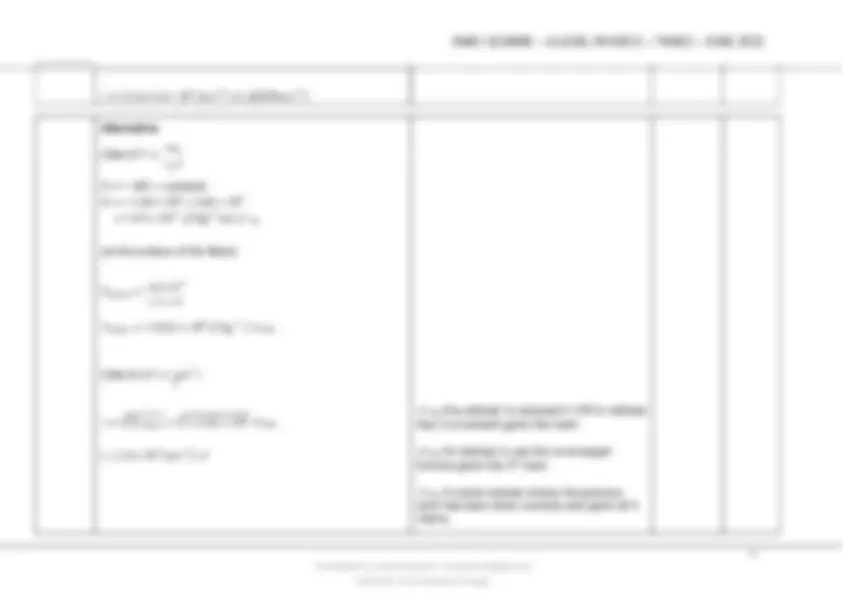
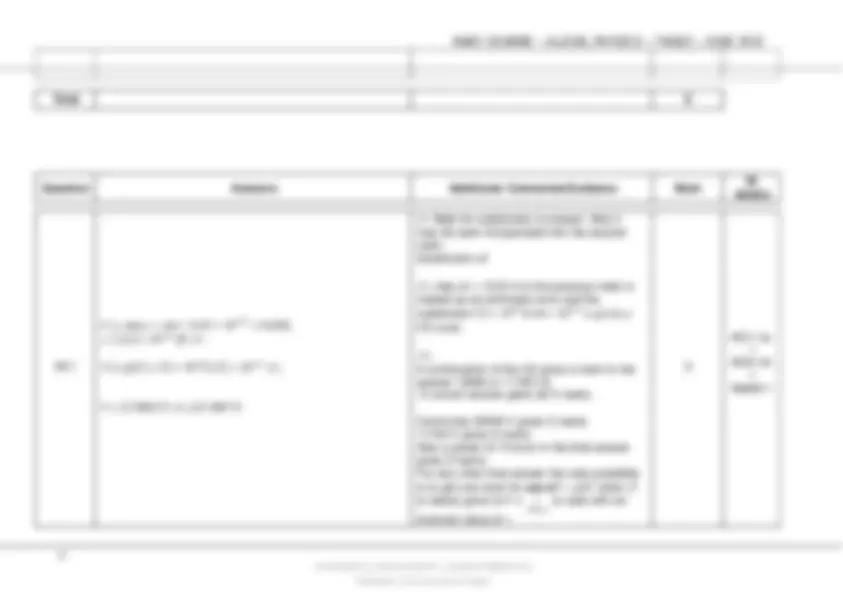
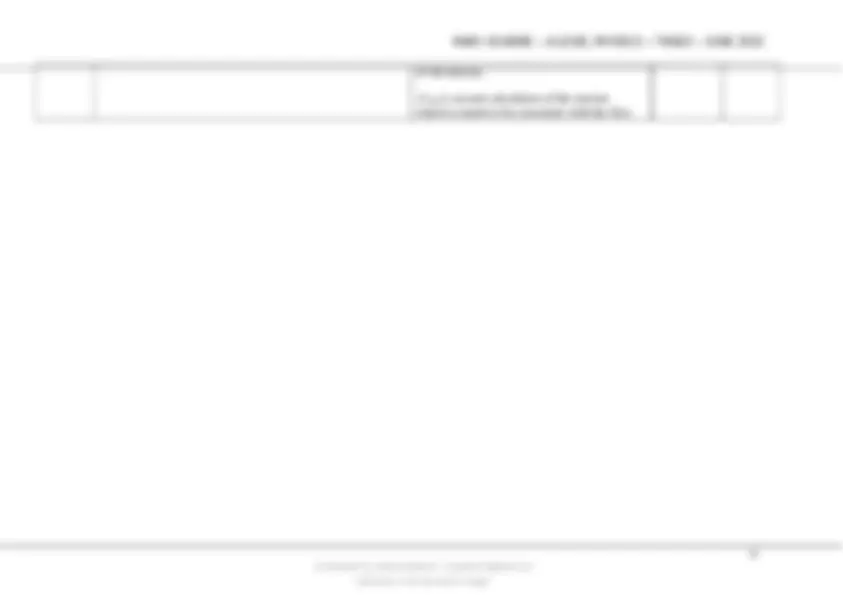

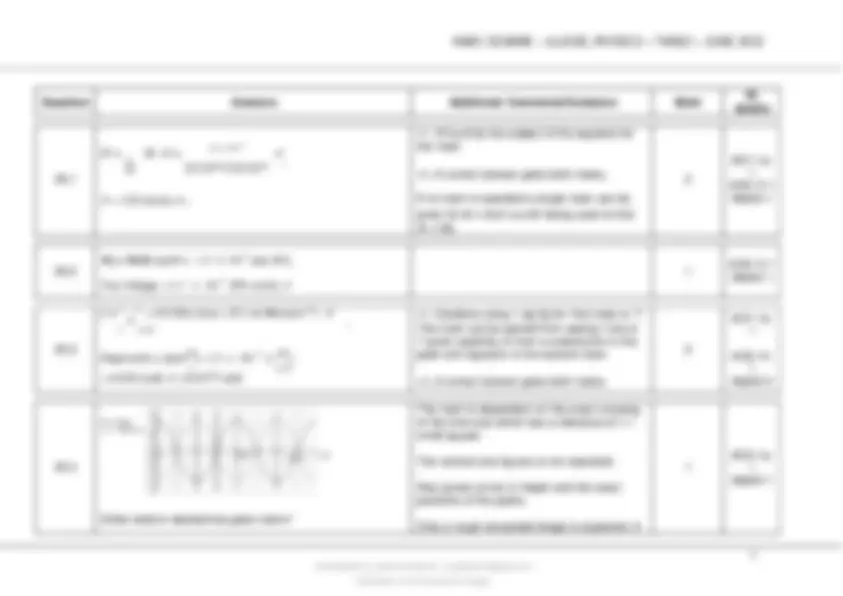
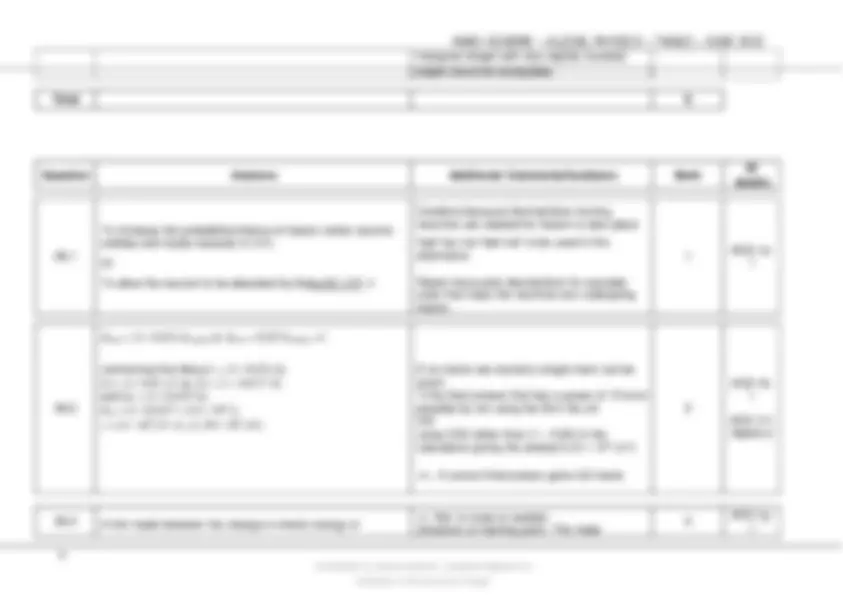
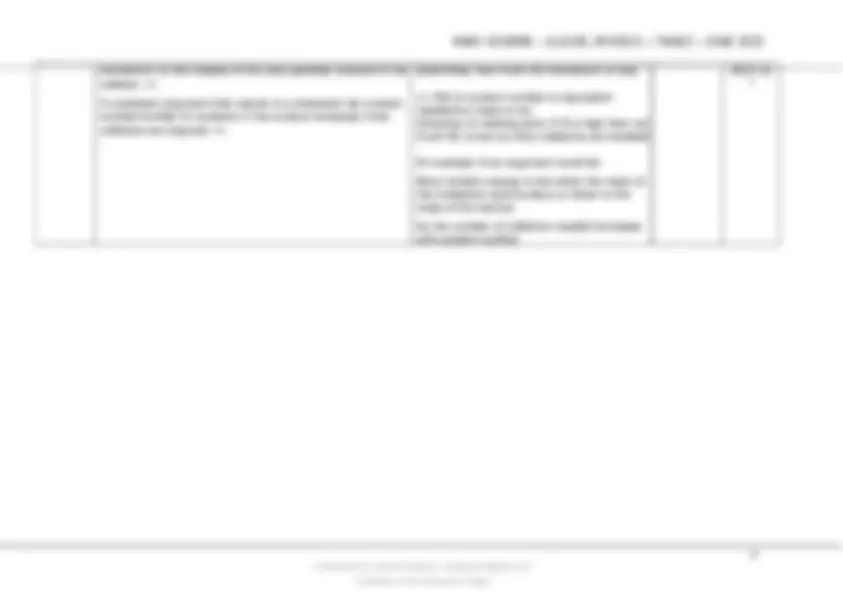
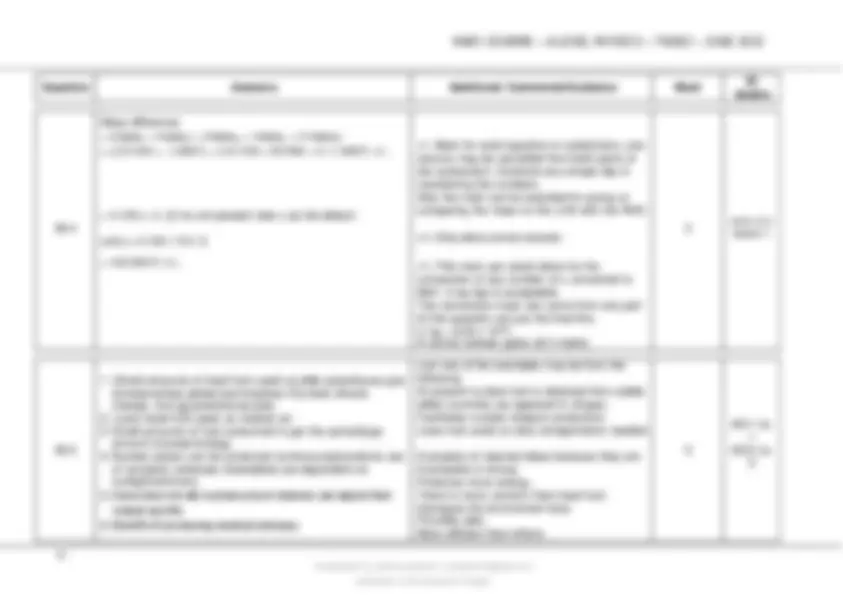
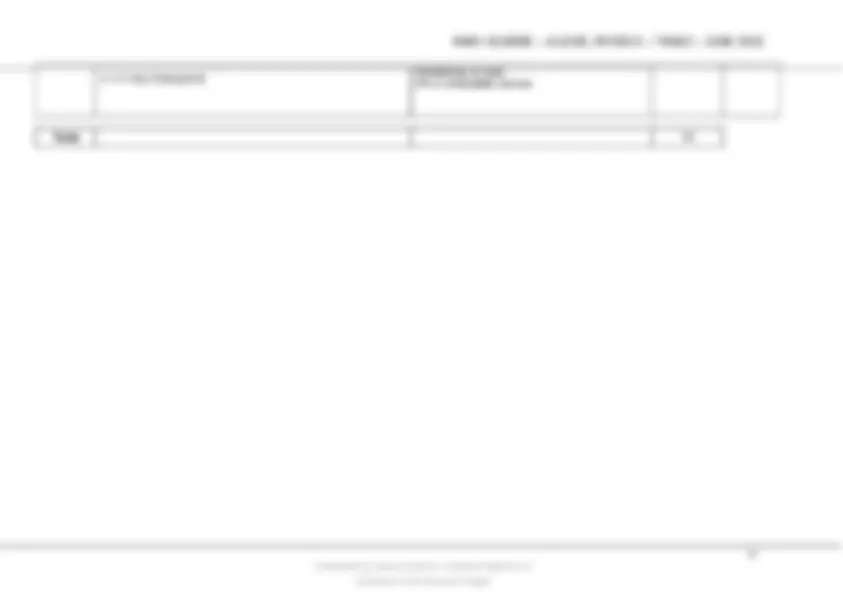
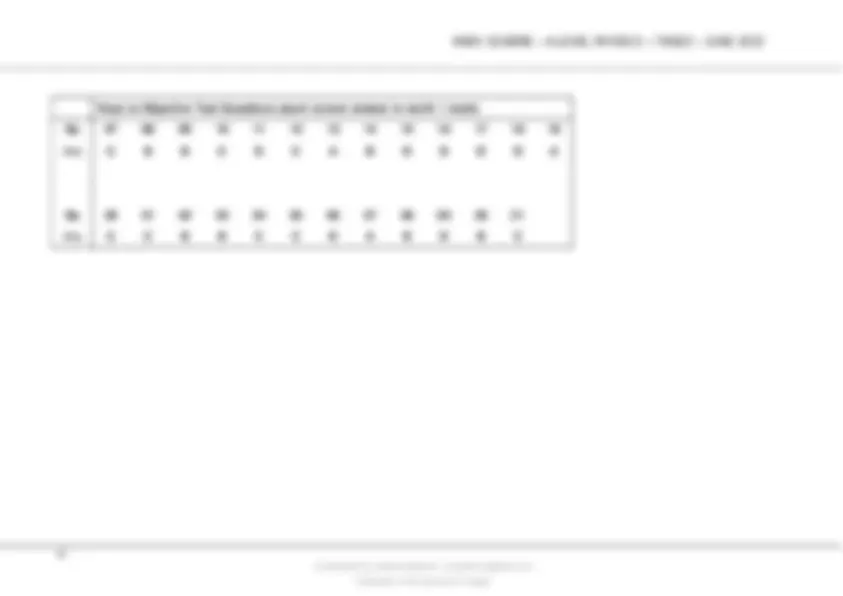


Study with the several resources on Docsity

Earn points by helping other students or get them with a premium plan


Prepare for your exams
Study with the several resources on Docsity

Earn points to download
Earn points by helping other students or get them with a premium plan
Community
Ask the community for help and clear up your study doubts
Discover the best universities in your country according to Docsity users
Free resources
Download our free guides on studying techniques, anxiety management strategies, and thesis advice from Docsity tutors
The mark scheme for the AQA AS Level Physics Paper 2 exam taken in June 2022. It provides instructions on how to mark the exam and allocate marks based on the level of response. The mark scheme also includes indicative content as a guide for examiners. specific questions and answers related to the exam, along with additional comments and guidance for each question.
Typology: Exams
1 / 25

This page cannot be seen from the preview
Don't miss anything!


















[Company address]
Mark schemes are prepared by the Lead Assessment Writer and considered, together with the relevant questions, by a panel of subject teachers. This mark scheme includes any amendments made at the standardisation events which all associates participate in and is the scheme which was used by them in this examination. The standardisation process ensures that the mark scheme covers the students’ responses to questions and that every associate understands and applies it in the same correct way. As preparation for standardisation each associate analyses a number of students’ scripts. Alternative answers not already covered by the mark scheme are discussed and legislated for. If, after the standardisation process, associates encounter unusual answers which have not been raised they are required to refer these to the Lead Assessment Writer.
It must be stressed that a mark scheme is a working document, in many cases further developed and expanded on the basis of students’ reactions to a particular paper. Assumptions about future mark schemes on the basis of one year’s document should be avoided; whilst the guiding principles of assessment remain constant, details will change, depending on the content of a particular examination paper.
Further copies of this mark scheme are available from aqa.org.uk
Level of response marking instructions
Level of response mark schemes are broken down into levels, each of which has a descriptor. The descriptor for the level shows the average performance for the level. There are marks in each level.
Before you apply the mark scheme to a student’s answer read through the answer and annotate it (as instructed) to show the qualities that are being looked for. You can then apply the mark scheme.
Start at the lowest level of the mark scheme and use it as a ladder to see whether the answer meets the descriptor for that level. The descriptor for the level indicates the different qualities that might be seen in the student’s answer for that level. If it meets the lowest level then go to the next one and decide if it meets this level, and so on, until you have a match between the level descriptor and the answer. With practice and familiarity you will find that for better answers you will be able to quickly skip through the lower levels of the mark scheme.
When assigning a level you should look at the overall quality of the answer and not look to pick holes in small and specific parts of the answer where the student has not performed quite as well as the rest. If the answer covers different aspects of different levels of the mark scheme you should use a best fit approach for defining the level and then use the variability of the response to help decide the mark within the level, ie if the response is predominantly level 3 with a small amount of level 4 material it would be placed in level 3 but be awarded a mark near the top of the level because of the level 4 content.
Once you have assigned a level you need to decide on the mark. The descriptors on how to allocate marks can help with this. The exemplar materials used during standardisation will help. There will be an answer in the standardising materials which will correspond with each level of the mark scheme. This answer will have been awarded a mark by the Lead Examiner. You can compare the student’s answer with the example to determine if it is the same standard, better or worse than the example. You can then use this to allocate a mark for the answer based on the Lead Examiner’s mark on the example.
You may well need to read back through the answer as you apply the mark scheme to clarify points and assure yourself that the level and the mark are appropriate.
Indicative content in the mark scheme is provided as a guide for examiners. It is not intended to be exhaustive and you must credit other valid points. Students do not have to cover all of the points
Downloaded by: jessicaonyebuchi | onyjessica1@gmail.com
Question Answers Additional Comments/Guidance Mark
details
Heat energy to evaporate nitrogen at its boiling point (= ml) =
(Use of 𝑄 = 𝑚𝑐∆𝜃) Attempt to use 𝑐 = ( 𝑄^ ) = (^10680 −^10000 )^ ➹ 𝑚×∆𝜃 0.050×( 77 − 70 ) 3
specific heat capacity of liquid nitrogen =
difference)
not present can come from the body of the answer space}
➹ 1 Substitution or answer.
➹ 2 Substitution or answer.
➹ 3 Allow any attempt at substitution with (77 –
➹ 4 Allow 1 sig fig due to the small temperature difference. No ecf – correct answer only.
AO1-1b- 2 AO2-1d- 3 Math2- 4
➹ 5 Correct answer Consistent with 4 th^ mark and only in the form shown ie no double or single solidus/oblique lines. Only penalise the kelvin unit if it has an obvious loop at the top – allow if simply small.
(Use of volume =𝑚^ ) 𝜌
correct}
810 OR a reference to the volume being negligible➹ 2
Work done in expanding (= X =𝑝Δ𝑉)
➹ 1 Substitution or answer and can be seen without label or explanation.
➹ 2 Substitution or answer or words.
➹ 3 Evidence of Δ𝑉 or calculation introduced with ‘work done =’ is required for the mark. For an ecf the product must be shown in full with the substitution of the ecf being clear.
AO1-1a- 1 AO2-1f- 1 AO3-1b- 2 Math2- 1
➹ 4 Allow ecf from 01.1 for this mark provided 4
Downloaded by: jessicaonyebuchi | onyjessica1@gmail.com
(ie X<Y) ➹ 4
the statement is consistent with the figures. OR If the ecf comes from the 3 rd^ mark above then the work done in expanding must be clearly labelled for the comparison or have units of J i.e it cannot be compared with a number that just happens to be on the page.
Total 9
Question Answers Additional Comments/Guidance Mark ID details
It is the sum/total of the (kinetic and potential) energies of the particles/atoms/molecules (that move at random in the gas➹) (^1)
For reference to kinetic energy of the gas or molecules➹ 2
➹ 1 Cannot be an average or a rms energy. Nor a vague reference to an energy of or in the gas.
➹ 2 This is independent of the first mark provided energy of the gas is given in some form. So here an average kinetic energy would be acceptable.
AO1-1a- 2
(Using) the gas laws it is the temperature at which the volume/pressure of a gas extrapolates to zero OR (Using pV = nRT or pV = NRT ) it is the temperature when pV or V or p is zero OR Plotting data of volume (or pressure) against temperature the plot extrapolates and crosses the temperature axis at absolute
➹1first Condone ‘becomes/is zero’ or phrases like ‘said to be zero’ or ‘thought to be zero’.
➹ (^1) second Just quoting Charles’ law or the Pressure law is not enough.
➹ (^1) third Allow the information in the form of a sketch.
AO1-1a- 2
5
Downloaded by: jessicaonyebuchi | onyjessica1@gmail.com
4.0 10
from the second mark. A correct answer gains all three marks
Alternative 2
(𝐸k)𝑎𝑣𝑒𝑟𝑎𝑔𝑒 =
OR
➹1Alt2 The mark can be given for evaluating either the average or the total kinetic energy.
➹2Alt2 Give a mark for this rearrangement and substitution even if the energy is incorrect. (𝐸k)𝑡𝑜𝑡𝑎𝑙 = (𝐸k)𝑎𝑣𝑒𝑟𝑎𝑔𝑒 × 𝑁A = 6.42 × 10−^21 × 6.02 × 10^23
(𝐸k)𝑡𝑜𝑡𝑎𝑙 = 3.86 × 10^3 (J) ➹1Alt
𝑐𝑟𝑚𝑠 must be the only unknown in the equation, data and constants to be shown.
➹3Alt2 Only allow a correct answer so no ecf from the second mark. 𝑐𝑟𝑚𝑠 = ( molar mass
) = ( k^ 𝑡𝑜𝑡𝑎𝑙) molar mass
A correct answer gains all three marks
= ( (^) − 2 ) ➹2Alt × (^) Note the slightly different answers for the third
(In equilibrium at the same temperature) both gases have the same mean or average kinetic energy➹
Allow ‘they are the same’ as a bold statement. However if this is not an opening statement following the question then ‘mean or average’ must be used.
AO2-1d- 1 Math2- 1
Particles/atoms/molecules collide with the piston/walls and change momentum ➹ 1
(The piston provides the) force = rate of change of momentum
➹ 1 Ignore any reference to particles colliding with each other. (^3)
AO1-1b- 2 AO2-1b- 1 7
Downloaded by: jessicaonyebuchi | onyjessica1@gmail.com
8
➹ 3 Relevant = reference to Piston or arising from the particles. (ie where or what)
If no mark is scored give a mark for P = F / A alone
(The particles give a force on the piston producing a pressure) A relevant reference to pressure = force divided by/over area or F / A ➹ 3
or impulse( Ft ) = change in momentum➹ 2
Downloaded by: jessicaonyebuchi | onyjessica1@gmail.com
Question Answers Additional Comments/Guidance Mark ID details
infinity to the point➹
A test mass should not be taken to be a unit mass. Ignore extra comments eg about charge.
1 AO1 1 - 1a-
The potential difference between the lines is constant but the distances are not Or
∆𝑟 ∆𝑟
Or The equipotential surfaces are not straight / not parallel / are curved ➹
The mark is given for the idea that the separation should be uniform or that equipotential lines should not be curved. Owtte Discussions should not imply there is a correct curvature.
Errors can come from references to the moon to first equipotential distance. Or by saying the potential gaps are not uniform or by saying the distance from the centre of the Moon is not proportional to the potential.
1 AO3-1a- 1
6 6
r 2
r
➹ 1 The mark is given for use and rearranging the equation so errors may be seen in the data and any equipotential may be used. Condone the misuse of a negative sign 4
AO3-1b- 1
➹ 2 Note All equipotential lines produce the same mass. The answer my be seen in the equations that follow.
➹ 2 An attempt to use this re-arranged formula gains this 3 rd^ mark. AO2-1f-^3 Math2- 2
10
Downloaded by: jessicaonyebuchi | onyjessica1@gmail.com
Alternative
GM − ) r
(at the surface of the Moon)
12
1.74 × 106
2
that it is constant gains this mark.
➹3Alt An attempt to use this re-arranged formula gains this 3 rd^ mark.
➹4Alt A correct answer shows the previous work has been done correctly and gains all 4 marks.
11
Downloaded by: jessicaonyebuchi | onyjessica1@gmail.com
One mark for stating the problem.➹ 1
One mark for giving a corresponding solution.➹ 2
For example Metallic or conducting instruments placed between the spheres will affect the separation (because of the movement of charge/electrons within the instrument) (Inside) calipers made from a non-conduction material in conjunction with a ruler could be used Or A travelling telescope on a vernier scale could be used (at a distance) Other examples of problems Physically touching the spheres may alter the reading. Difficulty of measuring distance between curved objects. A measuring instrument can have a dielectric constant/permittivity, which will affect the separation/disrupt the field. Reading a ruler behind the spheres will give rise to a parallax error.
➹ 1 The problem must be explicitly stated but not much detail is needed. EG Anything used between the spheres my disrupt the field.
➹ 2 The solution must be detailed enough to convey what must happen.
Other examples of solutions. Ruler and set square set up parallel to the line joining the centres of the spheres. Measure (beforehand) the length of thread y and measure the angle with a protractor and calculate distance x using trig’.
AO2-1c- 2
13
AO1-1c- 2 2
For the electrostatic force label also allow Felec or ‘force between charges. FA etc.
Ignore gravity between spheres. If a reaction force given – max 1 mark.
Labelled arrows on B
2 marks for all 3 arrows and labels 1 mark for 2 arrows and labels 1 mark for 3 arrows, no or incomplete labels
Downloaded by: jessicaonyebuchi | onyjessica1@gmail.com
Or Stating that the charge can be considered to be in the centre of each sphere ➹ 1
( 52 × 10 −^9 )
2
4 𝜋𝗌𝑜𝑟^2 4 𝜋𝗌𝑜(0.080)^2
➹ 2 Power of 10 errors are condoned and so is the use of the wrong separation (as this was penalized in the previous mark).
➹ 3 No ecf for this final mark.
AO1-1a- 1 AO2-1f- 1 Math2- 2
(As each sphere is in equilibrium then tan 𝜃 =
F electrostatic a mg mark is given for a reference and substitution into this equation in any configuration. The second mark is for an
given in 04.4 gains full credit.)
3.2×10-^3 ×9. or
or − 3
9.8 tan 7 o Alternatively 𝑇 = 3.2×10^ −×9.8^3 = 0.032 ➹ cos 7 o^ 1Alt
− 3 and 𝑇 = 3.8×10^ = 0.031 , the same value so consistent ➹ sin 7 o^ 2Alt
More circular routes using Pythagoras are possible but they end in the same calculated results.
AO2-1f- 2 Math2- 2
14
details
Question Answers Additional^ Comments/Guidance Mark^ ID
Downloaded by: jessicaonyebuchi | onyjessica1@gmail.com
Question Answers Additional Comments/Guidance Mark ID details
(In the following calculations condone the use of 1 sig fig for all data) 𝐺𝑀𝑚 (^) – 11 (3.2×10−^3 )^2
𝑟^2 0.080^2
Alternative (find the ratio between the forces)
𝑄 1 𝑄 2 ( 𝐹𝑒𝑙𝑒𝑐^ = 4 𝜋𝜀𝑜𝑟
2 𝐹𝑔𝑟𝑎𝑣 𝐺𝑀𝑚^ ) 𝑟^2
𝐹𝑔𝑟𝑎𝑣 𝑀𝑚 𝐺 4 𝜋𝜀𝑜
(mark given for this ratio or the substitution below)
𝐹 ( 52 × 10 −^9 )
2 𝑒𝑙𝑒𝑐 1
𝐹𝑔𝑟𝑎𝑣 (^) (3.2× 10 −^3 )^2 6.67× 10 −^11 × 4 ×𝜋×8.85× 10 −^12
➹1a It is the use of the formula that is
important for the mark. Giving the equation in symbols followed by an answer gains the mark.
➹2a No ecf for the second mark in order to keep the same level of difficulty as in the alternative.
AO3-1a- 2 Math2- 2
Total 14
16
Downloaded by: jessicaonyebuchi | onyjessica1@gmail.com
Question Answers Additional Comments/Guidance Mark
details
− 3 Φ^ ➹ 𝐴𝐵 2.5 × 10 −^2 × 5.0 × 10 −^4
➹ 1 N must be the subject of the equation for the mark.
➹ 2 A correct answer gains both marks.
If no mark is awarded a single mark can be given for Φ = 𝐵𝐴𝑁 cos 30 o^ being used to find N =139.
AO1-1a- 1 AO2-1f- 1 Math2- 1
AO2-1f- 1 Math2- 1
1 1
𝑇 0.25 1
Peak emf (= 𝐵𝐴𝑁
2 𝜋
2 π ) 𝑇 0.
➹ 1 Condone using 1 sig fig for f but not or T. The mark can be gained from seeing f or or T given explicitly or from a substitution in the peak emf equation in the second mark.
➹ 2 A correct answer gains both marks.
AO1-1a- 1
AO2-1h- 1 Math2- 2
Either solid or dashed line gains mark➹
The mark is dependent on the exact crossing of the time axis which has a tolerance of ± 1 small square.
The vertical axis figures is not expected.
Also ignore errors in height and the exact positions of the peaks.
Only a rough sinusoidal shape is expected. A
AO3-1a- 1 Math2- 1
17